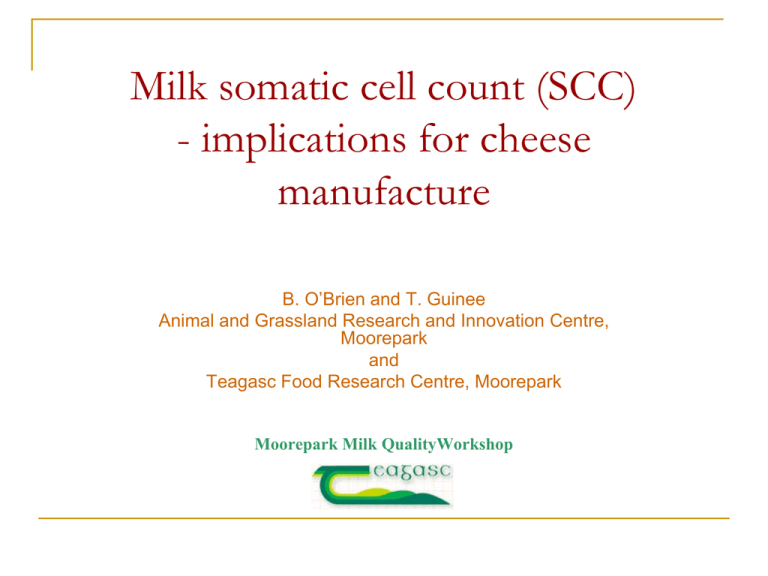How milk somatic cell count (SCC) affects the quality
advertisement

Milk somatic cell count (SCC) - implications for cheese manufacture B. O’Brien and T. Guinee Animal and Grassland Research and Innovation Centre, Moorepark and Teagasc Food Research Centre, Moorepark Moorepark Milk QualityWorkshop Cheese facts Estimated yield of 1 kg Cheddar cheese/10 kg milk Total milk used for cheese is ~25% ~70 - 90% in some European countries (Italy, France, Denmark and Germany) to ~0.5% in China. Production has increased consistently over the last two decades at an annual average rate of ~1.5%. Greater emphasis on improved quality and consistency (fat, protein, calcium and sodium), physical properties (texture and cooking attributes), sensory characteristics and processability Quality – milk – competitive advantage Quality of raw milk for cheese manufacture Is largely defined by: Milk composition Microbial activity of milk Somatic cell count (SCC) Enzymatic activity of milk Chemical residues Somatic cells Released from the blood to combat udder infection, and thereby, prevent or reduce inflammation (mastitis) Factors that contribute to increases in SCC of bulk manufacturing milk include: sub-clinical mastitis, advance in stage of lactation, lactation number, stress and poor nutrition. Dilution of high SCC milk Milk from infected (mastitic) quarters - SCC 2005,000 x 103 cells/mL. Excluded from the commercial milk supply The initial stage of mastitic infection (subclinical) not detectable by visual examination - part of bulk herd milk and bulk manufacturing milk Bulking dilutes high SCC milk, but also contributes to an increased SCC of manufacturing milk Managing bulk milk SCC SCC and milk characteristics Increasing SCC in milk is associated with marked changes in the: concentrations of milk constituents, state (degree of hydrolysis) of the milk components cheesemaking properties Increase in SCC 100 x 103 to 1,000 x 10 3 cells/mL: reduced lactose, fat and casein contents in milk casein as a percentage of true protein gel firmness recoveries of protein from milk to cheese cheese yield increased milk pH levels of chloride, whey protein and non-protein nitrogen curd fines in cheese whey cheese moisture rates of primary /secondary proteolysis during maturation Increased fat and protein losses during cheese manufacture 9.4 9.2 9.0 8.8 8.6 8.4 >1000 1000 900 800 700 600 500 400 300 200 8.2 100 Moisture-adjusted cheese yield (kg/100 kg milk) Effect of somatic cell count (SCC) on the moistureadjusted (to 37%) Cheddar cheese yield Somatic cell count (x 103 cells/mL) Increasing SCC in the range 100 x 103 to 600 x 103 : ~ 6 % reduction in moisture-adjusted Cheddar cheese yield Further SCC studies Increasing SCC from 100 x 103 to 200 x 103 cells/mL reduction in yield (i.e. ~0.4 kg/100 kg milk) Increasing SCC from >300 x 103 to >500 x 103 cells/mL in late lactation (220 DIL) results in: 9.3 % decrease in moisture-adjusted (to 35.5 %) yield of Cheddar cheese and decreases in the recovery of fat (90.1 to 86.6 %) and protein (78.3 to 74.4 %) Increasing SCC 83 x 103 to 872 x 103 cells/mL 4.3 % reduction in the percentage yield efficiency Cottage cheese Effect of SCC on milk processing The negative impact of SCC on yield and recoveries are mainly due to: increase in proteolysis of αs- and β-caseins to products soluble in the serum and not recovered in the cheese (γ-caseins, proteose peptones and other peptides) proteolysis arises from the elevated activity of plasmin plasminogen plasminogen activator in the milk High SCC - Slower curd-firming rate Lower concentration of αs- and β-caseins results: a slower curd-firming rate a lower degree of casein-casein interaction in the gel following cutting (at a given firmness) and during the early stage of stirring Such a gel has : a greater susceptibility to shattering during cutting and the early stages of stirring, resulting in higher losses of curd fines and fat and an impaired syneretic capacity, with a consequent increase in moisture level High SCC - Reduces firmness at cutting High SCC can inhibit activity of some strains of lactococci which further impairs curd firming rate and reduces firmness at cutting Large modern factories, cannot test curd firmness of cheese vats from separate milk silos because of the large scale of operation and the use of pre-programmed vats with limited operator access In commercial practice, the gel is generally not cut on the basis of firmness, but rather on the basis of a pre-set renneting time In such operations, the effects of increases in SCC may be increased as the slower-than-normal curd firming rate is conducive to lower-than-optimum firmness at cutting. SCC legislation The EU has set the legislative limit of ≤400 x 103 SCC/mL The permitted SCC limit varies internationally, but pressure to reduce SCC further, e.g. Bonus for < 200 x 103 cells/mL It is considered by some research that milk constituents ‘abandon their physiological ranges’ at SCC >100 x 103 cells/mL and that ‘infection’ is present at SCC > 100 x 103 cells/mL In conclusion High SCC detrimental to cheese yield and cheesemaking profitability Monetary loss resulting from a 2 % reduction in cheese yield on increasing the SCC from 100 x 103 to 500 x 103 cells/mL would be ~€4000 per day for a Cheddar cheese plant processing 1 M litres milk per day (at a fresh curd value of ~€ 2.0/kg) Must reduce SCC through the use of: good on-farm practices e.g., reducing the percentage of animals in herds with sub-clinical mastitis, meeting regulations, introduction of payment incentives for lower SCC Milk quality will increasingly contribute to competitive advantage for the Irish dairy industry – MQ vital to successfully compete in international markets







